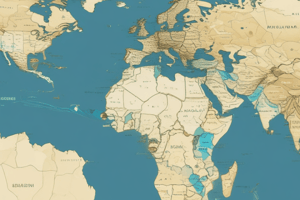Podcast
Questions and Answers
What does population growth refer to?
What does population growth refer to?
- The decrease in the number of individuals in a population over a specific period of time
- The movement of people from one place to another
- The change in population density over time
- The increase in the number of individuals in a population over a specific period of time (correct)
Which factor can contribute to the growth of a population?
Which factor can contribute to the growth of a population?
- Low fertility rates
- High mortality rates
- Low migration
- High migration (correct)
What is the term used to describe the number of children born per woman?
What is the term used to describe the number of children born per woman?
- Fertility rates (correct)
- Migration rates
- Mortality rates
- Population density
What is expected regarding the global population by the end of the century?
What is expected regarding the global population by the end of the century?
What can low mortality rates lead to in terms of population size?
What can low mortality rates lead to in terms of population size?
Which demographic factor has contributed significantly to the world's population growth?
Which demographic factor has contributed significantly to the world's population growth?
What does population density refer to?
What does population density refer to?
What are population dynamics influenced by?
What are population dynamics influenced by?
Why is understanding population dynamics crucial for policymakers?
Why is understanding population dynamics crucial for policymakers?
What do demographics refer to?
What do demographics refer to?
What is the demographic transition characterized by?
What is the demographic transition characterized by?
What challenges can arise from high population density?
What challenges can arise from high population density?
How does the world's current situation relate to the demographic transition?
How does the world's current situation relate to the demographic transition?
What implications can come from changes in demographics?
What implications can come from changes in demographics?
Why is understanding population growth essential?
Why is understanding population growth essential?
What do high fertility rates contribute to during the demographic transition?
What do high fertility rates contribute to during the demographic transition?
Flashcards are hidden until you start studying
Study Notes
Introduction
The population of the world has experienced significant growth in recent centuries, with the world population reaching 1 billion people in 1800 and continuing to increase rapidly. This growth has led to major demographic changes, which in turn have various implications for economics, politics, and society. In this article, we will explore the topic of population, focusing on population growth, population density, population dynamics, and demographics.
Population Growth
Population growth refers to the increase in the number of individuals in a population over a specific period of time. The world population has grown rapidly, particularly in the 20th century, with significant shifts in population size, fertility, and mortality. However, the growth rate is slowing down, and most demographers expect the global population to peak or slow down significantly by the end of the century.
Factors Affecting Population Growth
Several factors contribute to population growth, including:
- Fertility rates: The number of children born per woman. High fertility rates contribute to the growth of the population.
- Mortality rates: The number of people who die per unit of time. Low mortality rates can lead to a larger population size.
- Migration: The movement of people from one place to another, which can either increase or decrease the population size.
Population Density
Population density refers to the number of individuals living in a specific area, such as a country or region. High population density can lead to challenges in providing adequate resources, infrastructure, and services for the population. Population density can be influenced by factors such as urbanization, economic development, and government policies.
Population Dynamics
Population dynamics describe the changes in population size, structure, and distribution over time. These dynamics are influenced by various factors, including fertility rates, mortality rates, and migration patterns. Understanding population dynamics is crucial for policymakers, as it helps them make informed decisions about resource allocation, infrastructure development, and social programs.
Demographics
Demographics refer to the characteristics of a population, such as age, gender, race, and income level. Changes in demographics can have significant implications for economics, politics, and society. For example, an aging population may require more resources for healthcare and social services, while a younger population may demand more investment in education and infrastructure.
Demographic Transition
The demographic transition is a period of rapid change in population size, fertility, and mortality. During this transition, population growth rates rise as death rates decline while birth rates remain high. The world is currently in the midst of a demographic transition, with different regions and countries at varying stages of this process.
Conclusion
Understanding population growth, population density, population dynamics, and demographics is essential for addressing the challenges and opportunities that arise from a changing global population. Policymakers, economists, and social scientists must continue to study these factors and develop strategies to ensure the well-being of all populations.
Studying That Suits You
Use AI to generate personalized quizzes and flashcards to suit your learning preferences.




